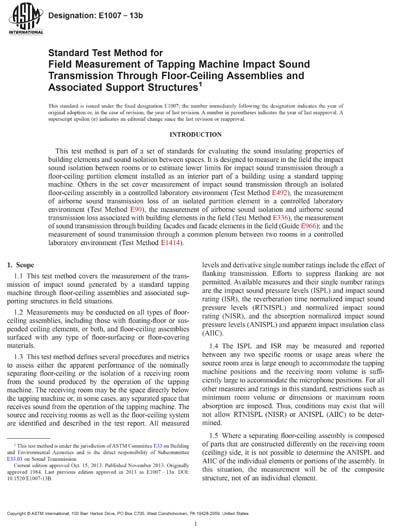Historical
ASTM E1007-13b
Standard Test Method for Field Measurement of Tapping Machine Impact Sound Transmission Through Floor-Ceiling Assemblies and Associated Support Structures
1.1 This test method covers the measurement of the transmission of impact sound generated by a standard tapping machine through floor-ceiling assemblies and associated supporting structures in field situations.
1.2 Measurements may be conducted on all types of floor-ceiling assemblies, including those with floating-floor or suspended ceiling elements, or both, and floor-ceiling assemblies surfaced with any type of floor-surfacing or floor-covering materials.
1.3 This test method defines several procedures and metrics to assess either the apparent performance of the nominally separating floor-ceiling or the isolation of a receiving room from the sound produced by the operation of the tapping machine. The receiving room may be the space directly below the tapping machine or, in some cases, any separated space that receives sound from the operation of the tapping machine. The source and receiving rooms as well as the floor-ceiling system are identified and described in the test report. All measured levels and derivative single number ratings include the effect of flanking transmission. Efforts to suppress flanking are not permitted. Available measures and their single number ratings are the impact sound pressure levels (ISPL) and impact sound rating (ISR), the reverberation time normalized impact sound pressure levels (RTNISPL) and normalized impact sound rating (NISR), and the absorption normalized impact sound pressure levels (ANISPL) and apparent impact insulation class (AIIC).
1.4 The ISPL and ISR may be measured and reported between any two specific rooms or usage areas where the source room area is large enough to accommodate the tapping machine positions and the receiving room volume is sufficiently large to accommodate the microphone positions. For all other measures and ratings in this standard, restrictions such as minimum room volume or dimensions or maximum room absorption are imposed. Thus, conditions may exist that will not allow RTNISPL (NISR) or ANISPL (AIIC) to be determined.
1.5 Where a separating floor-ceiling assembly is composed of parts that are constructed differently on the receiving room (ceiling) side, it is not possible to determine the ANISPL and AIIC of the individual elements or portions of the assembly. In this situation, the measurement will be of the composite structure, not of an individual element.
1.6 Any single field measurement only represents the performance of the actual assembly tested and cannot be used alone to accurately predict how an identical or similar assembly might perform.
1.7 The text of this standard references notes and footnotes which provide explanatory material. These notes and footnotes (excluding those in tables and figures) shall not be considered as requirements of the standard.
1.8 The values stated in SI units are to be regarded as standard. No other units of measurement are included in this standard.
1.9 This standard does not purport to address all of the safety concerns, if any, associated with its use. It is the responsibility of the user of this standard to establish appropriate safety and health practices and determine the applicability of regulatory limitations prior to use.
ASTM International [astm]

